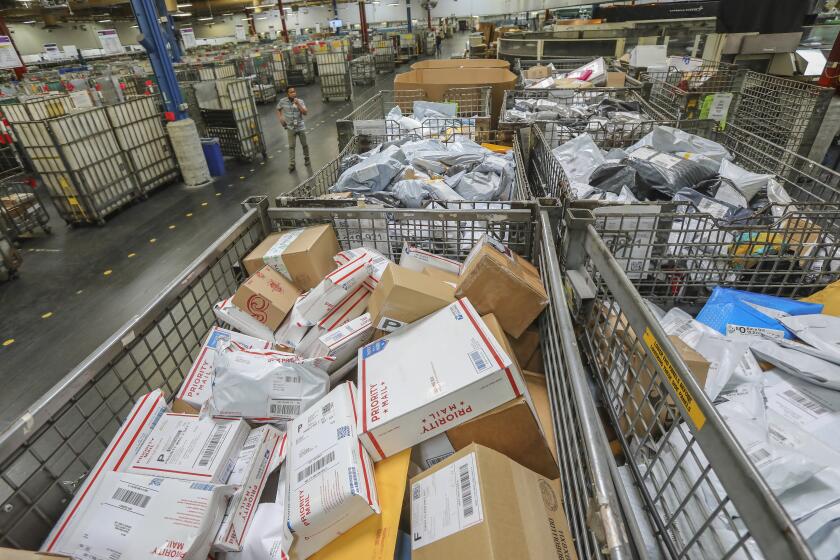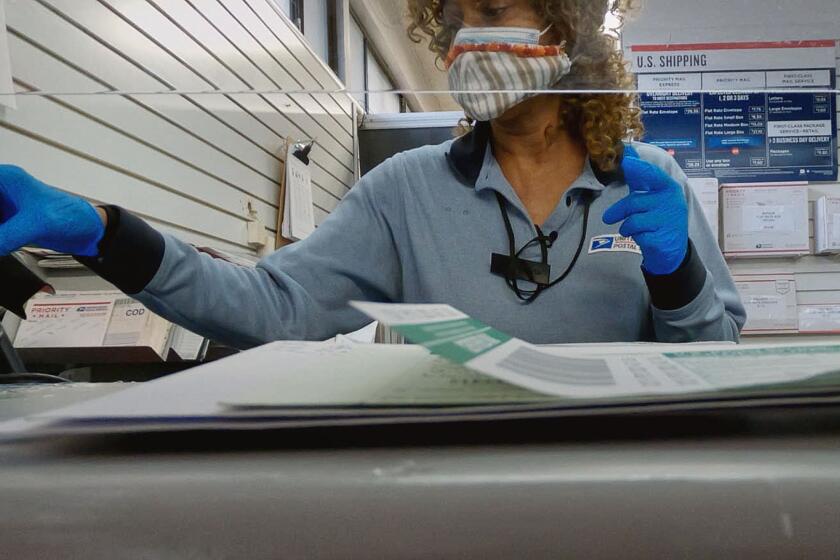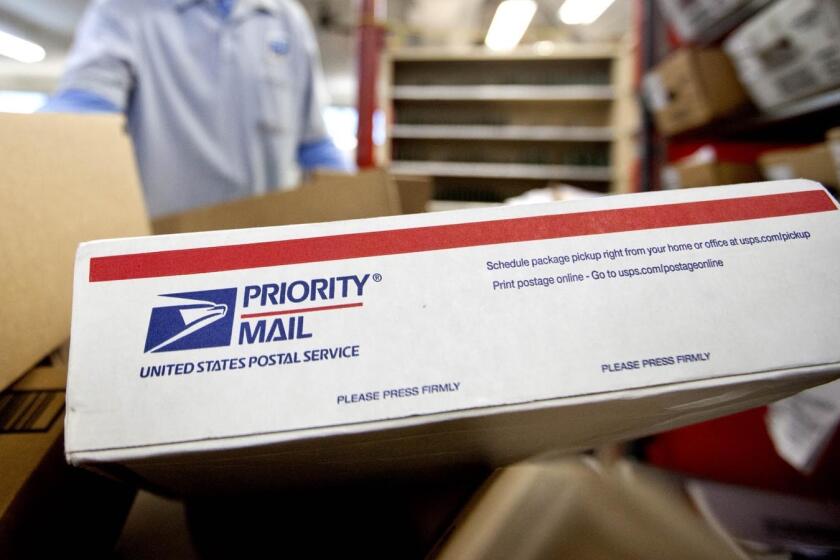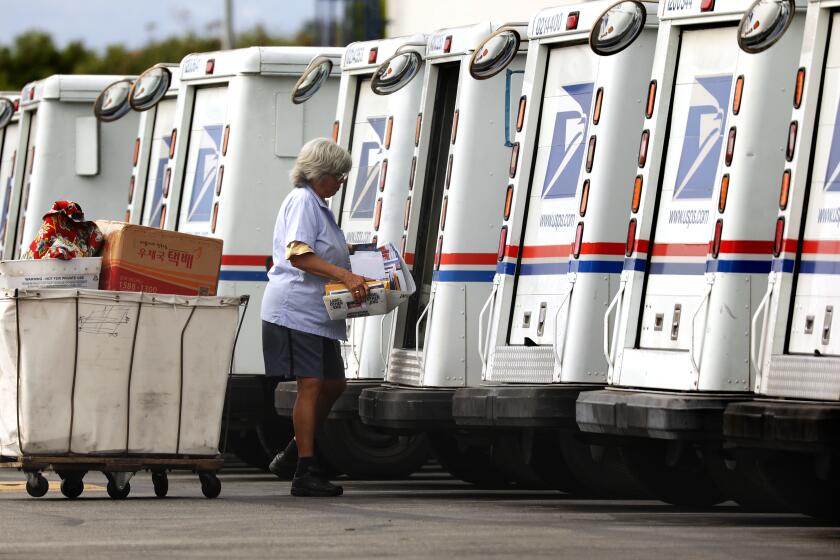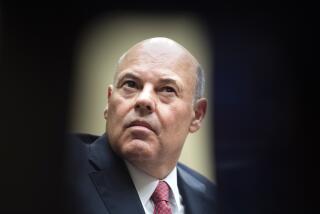Empty trucks, falsified records: How Louis DeJoy’s changes at the Postal Service brought chaos
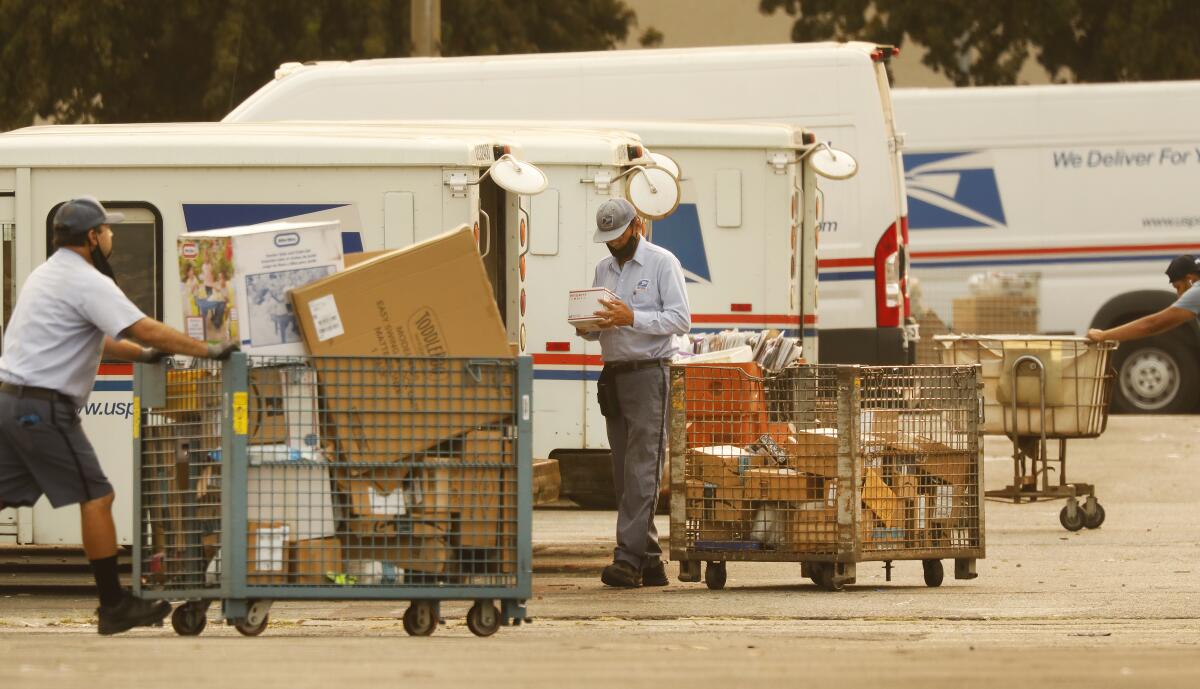
- Share via
For new Postmaster General Louis DeJoy, who wanted the U.S. Postal Service to operate more efficiently, it seemed like an obvious fix: Just run the trucks on time.
So in July he ordered drivers to start leaving post offices and distribution centers exactly on schedule and curtailed extra trips to pick up any mail that missed earlier cutoffs.
The stricter deadlines sparked far less public outcry than the removal of more than 700 high-speed sorting machines at mail processing facilities around the country — but they were far more disruptive to the U.S. mail system, according to a Times investigation.
Weeks-long delays began to ripple through a system already reeling from COVID-19 absences and a surge in package delivery during the pandemic, shaking Americans’ faith in one of the country’s most popular services and raising concerns about how the Postal Service will handle mail-in ballots in November.
The abrupt scheduling move also raised more questions about DeJoy’s stewardship of the Postal Service, which has been marked by severe delivery snafus and charges by critics that he is working to slow service in order to help President Trump’s election bid by making voting by mail more difficult.
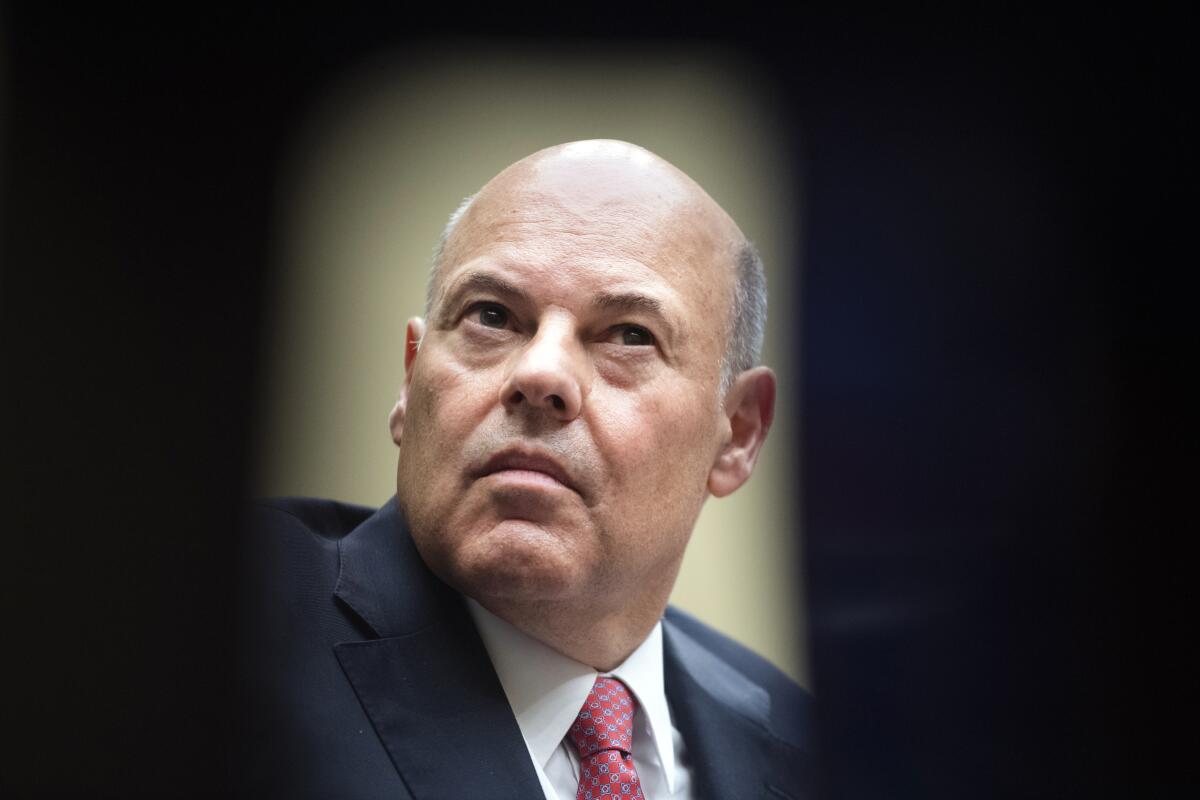
Workers who spoke to The Times described troubling details about how the rigid schedules have played out: Some trucks have traveled empty, and mail left behind has accumulated at massive processing centers, creating backlogs in a system that is not designed to store mail. Loading dock managers have falsified records so it appears that trucks are departing earlier, some mail has been sorted twice, and in at least one case, a large shipment from Amazon was turned away because facilities had no space to process it.
At a post office in Carmichael, Calif., near Sacramento, employees ran out of storage space and refused to accept about 1,500 packages from Amazon drivers Aug. 29, said Saintil Perry, president of the local chapter of the American Postal Workers Union.
“That’s a no-no. That’s revenue, regardless of how heavy the shipment is,” Perry said about refusing incoming parcels. “But they literally don’t have space. The letter carriers don’t have space. If they take on this mail, they won’t have time to leave because they would have to process it.”
At a massive mail facility in Santa Ana, tractor-trailers began pulling away from the docks even if workers were in the middle of loading them, said Will Khong, president of the postal union’s Orange County-area chapter.
That left-behind mail muddled one of the Postal Service’s key automated processes: sorting hundreds of thousands of letters into the exact order that they will be delivered along postal carriers’ routes. Workers had to sort some pieces of mail twice to ensure they were put in the proper order for the next day.
“We were just shaking our heads,” Khong said. “Why would you have a policy where you then have to run the mail twice — if all you have to do is have the trucks wait a few more minutes?”
Accounts from employees at California postal facilities provide a glimpse of the chaos amid both the pandemic and widespread cuts imposed by the USPS.
The share of first-class mail that was delivered on time across the U.S. fell by more than 9 percentage points during the time that DeJoy made his changes, according to agency data analyzed and released Wednesday by the office of Sen. Gary Peters (D-Mich.). In the first full week of July, before the trucking policy change, 90.6% of first-class mail was on time; in the second week of August, that had dropped to 81.5%, the analysis found.
Evelina Ramirez, a Postal Service spokeswoman, said mail delivery performance has improved since the end of July, when there were severe delays, and has returned to early July levels.
“This recovery took place while still adhering to our existing transportation schedules,” she said in an email. She did not respond to specific questions about Amazon boxes being returned, mail being sorted twice and other issues affecting delivery.
Times reporters who mailed 100 letters to five cities in late August found that at least 22 of the envelopes arrived late or were never delivered. One letter sent from Sylmar took 11 days to get to Austin, Texas. Another item mailed from Malibu sat in the Los Angeles processing center for three days before being delivered to a San Francisco suburb four days later.
Trucks are the main way the Postal Service moves mail, accounting for 65% of the agency’s transport costs, according to a recent report by the service’s Office of Inspector General. From origin to destination, a piece of mail may travel between numerous postal facilities. Even when airplanes are used, trucks carry the mail between airports and processing centers.
At the time DeJoy took office in June, about 88% of trucks were on time, he said in congressional testimony last month. A former logistics executive, DeJoy estimated that hewing to the written schedules would save at least $1 billion in late fees and labor costs, and would make mail delivery more reliable.
“Once you get below 90%, you can’t depend on anything…. FedEx, UPS, everybody runs their trucks on time,” DeJoy said. “That’s what glues the whole network together.”
Delayed transportation has been a longtime financial burden to the Postal Service, which spent $280 million on late and extra trips and $2.9 billion in delivery overtime and penalty overtime costs in the 2019 fiscal year, according to an inspector general’s report that landed the week DeJoy took office. Auditors also found that 20% of trips from processing facilities, or about 4 million, left late.
But auditors did not recommend immediate changes to the trucking schedule. Instead, they urged postal leaders to create an automated system to monitor the integration of the transportation, processing and delivery operations and, “once the impacts of COVID-19 subside,” to develop a plan to address staffing shortages.
DeJoy forged ahead anyway, making the trucking change over the summer. Around the same time, midlevel Postal Service managers began severely curtailing overtime, a change that DeJoy said he did not personally order.
“Theoretically, everyone should have got their mail faster,” DeJoy said. But problems quickly surfaced: Schedules at the processing and distribution facilities were not “fully aligned” with the trucks, he said.
Slow mail service from Los Angeles was one finding of an L.A. Times survey of Postal Service reliability amid deep cuts imposed by the Trump administration.
Had DeJoy spent more time familiarizing himself with the Postal Service’s vast, complicated delivery operation before making the changes, the problems could have been avoided, critics say.
“DeJoy is ignoring what an integrated network this is,” said Phil Rubio, a history professor at North Carolina A&T State University who worked as a distribution clerk and letter carrier for the Postal Service for two decades. “When you start to tinker with it in as many ways as he has, the system starts to break down.”
Put another way, said Mark Jamison, a retired postmaster in North Carolina: “DeJoy worked in logistics and probably does know that end of it. But when it comes to the rest of the system, I don’t think he knows his eyeball from a hole in the ground.”
Punctuality is important in the transportation world — in fact, it’s the primary way that trucking companies are evaluated in a highly competitive industry.
“The No. 1 thing in transportation or logistics is the timing,” said Finn Murphy, author of “The Long Haul: A Trucker’s Tales of Life on the Road,” who drove long-haul trucks for 20 years.
“Factories and groceries, for example, are based on ‘just-in-time delivery.’ Their whole business model is based on when they want it to be there. ‘When’ doesn’t mean 15 minutes later, it means a particular moment…. If you have to be there at 8:17, you have to be there at 8:17.”
Some postal managers say on-time transportation is essential because delayed trucks can cause mail to be late to processing centers, delivery units and airports, which interferes with the schedule and sorting operations of those facilities. Robert Cintron, vice president of logistics at the Postal Service, said in a declaration filed last week in a lawsuit over the mail delays that late transportation can mean mail does not make it onto a carrier’s truck on time and is not delivered on schedule.
But trucking is just one element in a system as time-sensitive as mail delivery, which requires flexibility in accommodating issues, including staffing shortages, machine breakdowns and a volume of mail that fluctuates by day, experts and workers said.
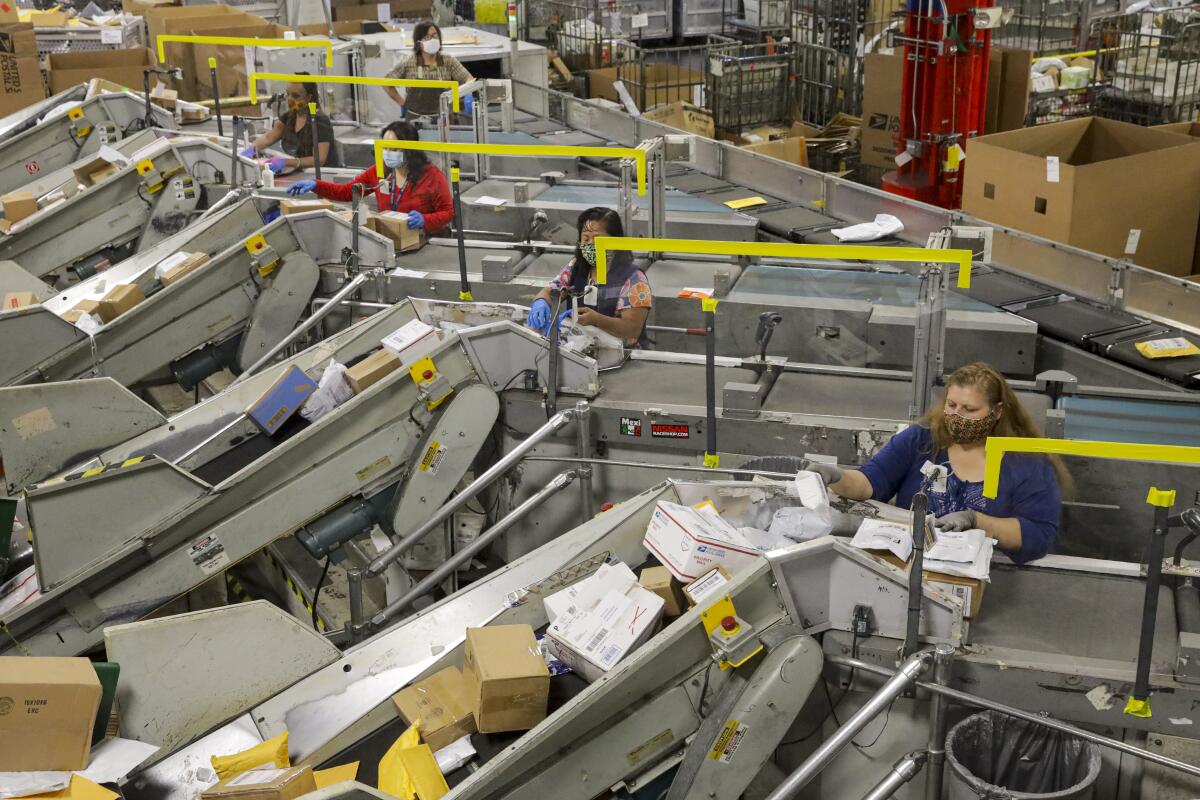
Millions of people have turned to online shopping during the pandemic, creating an unexpected surge of packages nearly equivalent to the holidays. The Postal Service handled 708 million more packages between April and June than in the same time last year, an increase of nearly 50%, the agency said.
Unlike during the holidays, the Postal Service did not add enough workers to handle the extra demand — and it was struggling with a high rate of absences due to COVID-19.
A wave of staff shortages and a sudden increase is a “recipe for disaster,” said Miguel Jaller, an associate professor at UC Davis who studies freight and logistics. The trucking change, he said, was “just the cherry on top for a system that has been stressed due to COVID-19 impacts.”
Some employees worry the mandate that trucks run on time may look like a success on paper only.
The COVID-19 pandemic and cutbacks at USPS have created chaos in the mail system. Do you work for the Postal Service? We want to hear from you.
In the San Diego area, postal employees have seen managers falsify records to make it look like tasks are being finished on time, said Bob Waterhouse, executive vice president of the San Diego chapter of the American Postal Workers Union.
Managers use scanners to read bar codes that signify when certain duties are complete, such as when mail has been sorted and when trucks leave from the loading docks. Some managers are deliberately scanning the codes early to make it look like sorting is finished more quickly and trucks are leaving earlier than they actually are, Waterhouse said.
“This is a way to show that the policy is working when it is not actually being practiced,” Waterhouse said. He said employees are being threatened with discipline if they override the false scans.
Robert Bockman, a tractor-trailer operator and vice president of the Puget Sound-area union chapter in Washington state, said he’s also been made aware that managers are trying to scan trucks out early.
He said the mandate to be punctual is so overplayed that he and other drivers are being told to leave the loading docks five minutes early, regardless of whether all the mail is on board.
“I feel like I’m in a day care,” Bockman said, noting that someone has put signs up in Seattle and Tacoma processing facilities that feature clip art of a stopwatch and say “5 Minutes Early Is The New ON TIME!” with the phrase “NO EXCEPTIONS” in bold red type.
“The micromanagement has really caused issues in the workplace,” Bockman said. “It’s stressful. You don’t want to be late, and you sure as hell don’t want to be talked to by supervisors” about it.
Bockman said the pressure to leave five minutes early means that about four times a week he has been driving down freeways with an empty trailer.
Requiring trucks to leave exactly on time, or early, can exacerbate other problems at sorting facilities, including machines breaking down, a shortage of workers or a higher volume of mail than usual, union leaders say.
The trucking schedule change “seemed like the smallest thing, but it was the biggest thing to hurt the Postal Service,” said Eddie Cowan, president of the L.A.-area chapter of the National Postal Mail Handlers Union.
At a sorting facility in Los Angeles, workers said that some days they missed getting mail onto trucks by a matter of minutes. Several times, they said, tractor-trailers pulled away while workers were headed toward the loading docks with cartons of sorted letters and parcels.
Those changes, coupled with a cutback in overtime, left the facility swamped with backlogged packages for weeks. Steaks and fruit rotted inside their boxes and chicks were found dead in their packages, a Times investigation found. Conditions have gradually improved there, workers said.
Critical prescriptions are being delayed, placing many Americans’ health in jeopardy. New credit cards, rent checks, stimulus payments from the Internal Revenue Service — all have been stalled.
The effects of the change have rippled out to local post offices. Carriers across the state said they have seen outgoing mail — which is supposed to be sent for sorting the same day it is received — sitting in the post office the following morning.
Leftover mail is disruptive to the system because postal facilities aren’t designed to store letters and packages, said Robert Fisher, a former Postal Service executive and owner of Fisher Postal Analytics, where he researches mail performance.
Every day, managers specifically monitor how much mail is in a facility — known as on-hand volume — to make sure the levels do not get out of control, he said.
“Leaving mail behind would increase on-hand volumes, disrupting the control processes and system balance,” Fisher said.
He described on-time trucks as just one element in a cycle of daily events that indicate how smoothly the mail system is running. The other pieces include the time carriers return from their routes in the evening, postmarking mail at night and sorting the carrier’s mail before dawn. Making trucks leave on time without all the mail wouldn’t necessarily make the other processes fall into place — in fact, it could throw them off kilter, he said.
In the Ocean Beach neighborhood of San Diego, a mail carrier arrived at work the morning of Aug. 18 to find tubs of mail sitting outside an office. The mail had been collected the day before but never made it to the plant because it had missed the last truck.
The carrier, a 22-year veteran of the Postal Service who was not authorized to speak publicly, said that would not have happened in the past; a post office manager would have authorized overtime for an employee to make an extra trip to the distribution facility.
“Some way or another, we always got the mail out every day,” the carrier said.
More to Read
Sign up for Essential California
The most important California stories and recommendations in your inbox every morning.
You may occasionally receive promotional content from the Los Angeles Times.
